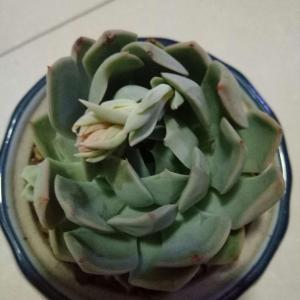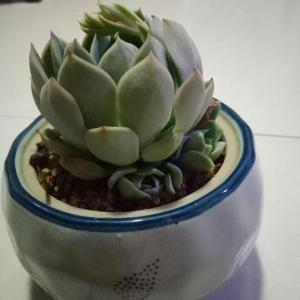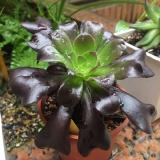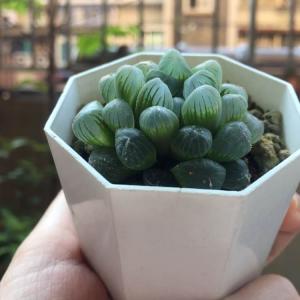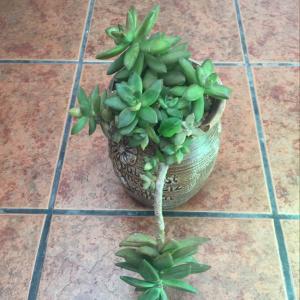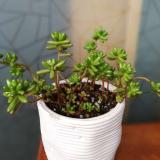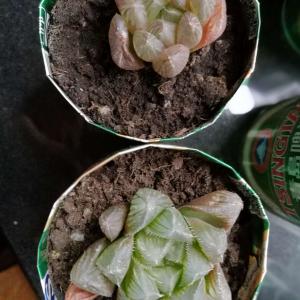文章
Miss Chen
2018年03月31日

Description: This herbaceous perennial plant is 1-2' tall, branching occasionally. The stems are sharply 4-angled and usually glabrous, although scattered hairs may occur along the ridges on relatively new growth. The opposite leaves are up to 3½" long and 2" across. They are sessile against the stem, or have very short petioles. The leaves are broadly lanceolate or ovate, with serrate margins that are often ciliate. The upper surface of each leaf is often finely pubescent, while a few hairs may occur along the major veins on the lower surface. The upper surface is green or yellowish green, sometimes with scattered purple spots or a purplish tint along the margin. The upper stems terminate in dome-shaped flowerheads (a single flowerhead per stem). These flowerheads are about 1½–3" across. A small wreath of flowers first appears toward the center of the flowerhead, and spreads gradually towards the outer edge of the flowerhead.
Each narrow flower is about 1" long, and has a corolla that is deeply divided into prominent upper and lower lips. The upper lip is nearly tubular and contains the exerted stamens, while the lower lip is somewhat wider and has a narrow lobe at its tip that curls downward. The corolla is white or pink, with purple dots on the lower lip, and white hairs on the upper lip. The calyx of each flower is tubular and hairy, with 5 pointed lobes at its tip. Immediately beneath each flowerhead are 5 leafy bracts that are triangular-shaped. These bracts often have ciliate margins, and they are often colored faded pink or purple. The blooming period occurs during the late spring or early summer and lasts about a month. There is no floral scent, although the foliage exudes an oregano scent. The nutlets are dispersed to some extent by the wind. The root system produces abundant rhizomes, enabling vegetative reproduction.
Cultivation: The preference is partial sun and somewhat dry conditions. This species often grows in soil that is somewhat thin and rocky, which reduces competition from other species of plants. The lower leaves will fall off the stems during drought; in stressed-out plants, the foliage may become discolored and diseased.

Range & Habitat: The native Bradbury's Bee Balm occurs occasionally in the southern half of Illinois, while elsewhere within the state it is rare or absent (see Distribution Map). Habitats include rocky upland forests, savannas, thickets, limestone or sandstone glades, bluffs, meadows in wooded areas, pastures, and roadsides. This species probably benefits from occasional wildfires to create clearings in woodland areas.
Faunal Associations: Long-tongued bees (especially bumblebees), butterflies, skippers, Hummingbird moths, beeflies, and hummingbirds visit the flowers for nectar. The small black bee Doufourea monardae is a specialist pollinator of Monarda spp. Short-tongued Halictid bees may visit the flowers to collect pollen; they are unable to reach the nectar. Caterpillars of the moths Sphinx eremitus (Hermit Sphinx), Anterastria teratophora (Gray Marvel), Pyrausta orphisalis (Pyralid Moth sp.), and Pyrausta signatalis (Pyralid Moth sp.) feed destructively on Monarda spp. (Bee Balms). Other insect feeders include the scentless plant bug Arhyssus nigristernum, the leaf-footed bug Euthochtha galeator, the aphid Hyalomyzus monardae, and the leaf beetle Physonota unipunctata. Mammalian herbivores usually avoid consumption of Monarda spp. – it is possible that the oregano scent of the foliage deters them.

Photographic Location: An upland savanna at Warbler Woods in Coles County, Illinois, and a restored prairie at Meadowbrook Park in Urbana, Illinois.
Comments: Bradbury's Bee Balm is fairly easy to identify. Like other Monarda spp., the large flowers have a distinctive appearance that is showy and attractive. Bradbury' Bee Balm differs from other Monarda spp. in Illinois by its sessile or nearly sessile leaves, and the purple dots on the lower lip of the corolla. It is also shorter in stature and blooms earlier. The species Monarda russeliana of some authors is probably the same species as Monarda bradburiana.
Each narrow flower is about 1" long, and has a corolla that is deeply divided into prominent upper and lower lips. The upper lip is nearly tubular and contains the exerted stamens, while the lower lip is somewhat wider and has a narrow lobe at its tip that curls downward. The corolla is white or pink, with purple dots on the lower lip, and white hairs on the upper lip. The calyx of each flower is tubular and hairy, with 5 pointed lobes at its tip. Immediately beneath each flowerhead are 5 leafy bracts that are triangular-shaped. These bracts often have ciliate margins, and they are often colored faded pink or purple. The blooming period occurs during the late spring or early summer and lasts about a month. There is no floral scent, although the foliage exudes an oregano scent. The nutlets are dispersed to some extent by the wind. The root system produces abundant rhizomes, enabling vegetative reproduction.
Cultivation: The preference is partial sun and somewhat dry conditions. This species often grows in soil that is somewhat thin and rocky, which reduces competition from other species of plants. The lower leaves will fall off the stems during drought; in stressed-out plants, the foliage may become discolored and diseased.

Range & Habitat: The native Bradbury's Bee Balm occurs occasionally in the southern half of Illinois, while elsewhere within the state it is rare or absent (see Distribution Map). Habitats include rocky upland forests, savannas, thickets, limestone or sandstone glades, bluffs, meadows in wooded areas, pastures, and roadsides. This species probably benefits from occasional wildfires to create clearings in woodland areas.
Faunal Associations: Long-tongued bees (especially bumblebees), butterflies, skippers, Hummingbird moths, beeflies, and hummingbirds visit the flowers for nectar. The small black bee Doufourea monardae is a specialist pollinator of Monarda spp. Short-tongued Halictid bees may visit the flowers to collect pollen; they are unable to reach the nectar. Caterpillars of the moths Sphinx eremitus (Hermit Sphinx), Anterastria teratophora (Gray Marvel), Pyrausta orphisalis (Pyralid Moth sp.), and Pyrausta signatalis (Pyralid Moth sp.) feed destructively on Monarda spp. (Bee Balms). Other insect feeders include the scentless plant bug Arhyssus nigristernum, the leaf-footed bug Euthochtha galeator, the aphid Hyalomyzus monardae, and the leaf beetle Physonota unipunctata. Mammalian herbivores usually avoid consumption of Monarda spp. – it is possible that the oregano scent of the foliage deters them.

Photographic Location: An upland savanna at Warbler Woods in Coles County, Illinois, and a restored prairie at Meadowbrook Park in Urbana, Illinois.
Comments: Bradbury's Bee Balm is fairly easy to identify. Like other Monarda spp., the large flowers have a distinctive appearance that is showy and attractive. Bradbury' Bee Balm differs from other Monarda spp. in Illinois by its sessile or nearly sessile leaves, and the purple dots on the lower lip of the corolla. It is also shorter in stature and blooms earlier. The species Monarda russeliana of some authors is probably the same species as Monarda bradburiana.
0
0
文章
Miss Chen
2018年03月30日

Description: This perennial herbaceous plant forms a rosette of basal leaves spanning ¾-2½' across. The basal leaves are ascending to widely spreading (usually the latter). Individually, these leaves are 4-18" long, ½-2¼" across, and sessile; they are oblong-lanceolate, oblong-oblanceolate, or oblong-elliptic in shape and their margins are finely dentate (denticulate) and, to a lesser extent, smooth (entire). The basal leaves are often folded upward along their margins, otherwise they are flat. The leaf surfaces are pale green, glabrous, and occasionally glaucous; sometimes they are speckled purple. The texture of these leaves is slightly succulent and stiff. At maturity, an erect flowering stalk (2-6' in length) develops from the rosette of basal leaves. This stalk is pale to medium green, terete, glabrous, and often glaucous. Along its length underneath the inflorescence, there are widely separated leafy bracts about ½-4" long that become smaller as they ascend the stalk. These bracts are linear-lanceolate, ascending to erect, and pale green. Toward the upper end of this stalk, there is a spike of 10-60 flowers about ½-2' long.

Each flower is ¾-1¼" long, approximately tubular in shape, whitish green or yellowish green, and ascending to erect. Each flower has a tubular corolla with 6 convex ridges, 6 narrowly triangular lobes that are held erect, 6 strongly exerted stamens, and an inferior ovary with exerted style. The tubular body of the corolla is about 2-3 times as long as its lobes; they are both pale green and glabrous. The filaments of the stamens are golden yellow; the long slender anthers are white, becoming brown and deciduous with age. The style is also golden yellow, except for its 3-lobed stigma, which is white. At the base of each flower, there is a membranous-leafy bract up to ½" long. The flowers are mostly sessile,Distribution Map although a few lower flowers may have very short pedicels. The blooming period occurs from early- to mid-summer. The flowers have a slight to moderate fragrance that is sweet and fruity. Afterwards, the flowers are replaced by 3-celled seed capsules that become about ½" long at maturity. These capsules are globoid-ovoid in shape and angular. Within each cell of a capsule, there are 2 rows of flattened seeds. Mature seeds are black and half-orbicular in shape; they can be blown about by the wind. The root system consists of a bulbous caudex with fibrous roots below.
Cultivation: The preference is partial to full sun, dry-mesic to dry conditions, and either thin rocky soil or sandy soil where there is reduced competition from other ground vegetation. Eastern Agave (Manfreda virginica) can be cultivated as an ornamental plant in the back of a rock garden. While the flowers are not particularly showy, the basal leaves are attractive. Because Eastern Agave has a Crassula acid metabolism (CAM), like cacti and other desert plants, it is very drought tolerant.
Range & Habitat: The native Eastern Agave (Manfreda virginica) is occasional in southern Illinois, while in the rest of the state it is absent. Illinois lies along the northern range-limit of this species. Habitats include rocky openings in upland woodlands, rocky ledges and cliffs along rivers or streams, thinly wooded rocky slopes, upland savannas, and rocky glades (including chert, sandstone, and limestone). Outside of Illinois, this species has also been found in sandy habitats. It occurs in higher quality natural areas.
Faunal Associations: The flowers are cross-pollinated by Sphinx moths, Noctuid moths, and bumblebees (Groman & Pellmyr, 1999). Generally, the moths have been found to be more important pollinators than the bumblebees. These visitors suck nectar from the flowers; some of the bumblebees also collect pollen for their larvae. Aside from its pollination ecology, little is known about the floral-faunal relationships for this species.
Photographic Location: A thinly wooded rocky slope in southern Illinois.
Comments: This is the only member of the Agave family that is native to, or has naturalized in, Illinois. The distinctive Agave-like leaves and the tall spike of greenish flowers makes this species easy to identify when it is encountered in the wild. Unlike true Agaves (Agave spp.), the Eastern Agave (Manfreda virginica) can bloom multiple times during its lifespan. In contrast, the true Agaves bloom only once at the end of their lifespans after a period of several years (or even decades). The latter can be found in the desert SW and Florida of the United States, in Mexico, and other countries further to the south. Other scientific names of Eastern Agave are Polianthes virginica and Agave virginica. Other common names for this species are Virginia Agave and False Aloe. Sometimes Eastern Agave is assigned to the Lily family (Liliaceae) when the Agave family (Agavaceae) is reclassified as a subfamily of the former family.

Each flower is ¾-1¼" long, approximately tubular in shape, whitish green or yellowish green, and ascending to erect. Each flower has a tubular corolla with 6 convex ridges, 6 narrowly triangular lobes that are held erect, 6 strongly exerted stamens, and an inferior ovary with exerted style. The tubular body of the corolla is about 2-3 times as long as its lobes; they are both pale green and glabrous. The filaments of the stamens are golden yellow; the long slender anthers are white, becoming brown and deciduous with age. The style is also golden yellow, except for its 3-lobed stigma, which is white. At the base of each flower, there is a membranous-leafy bract up to ½" long. The flowers are mostly sessile,Distribution Map although a few lower flowers may have very short pedicels. The blooming period occurs from early- to mid-summer. The flowers have a slight to moderate fragrance that is sweet and fruity. Afterwards, the flowers are replaced by 3-celled seed capsules that become about ½" long at maturity. These capsules are globoid-ovoid in shape and angular. Within each cell of a capsule, there are 2 rows of flattened seeds. Mature seeds are black and half-orbicular in shape; they can be blown about by the wind. The root system consists of a bulbous caudex with fibrous roots below.
Cultivation: The preference is partial to full sun, dry-mesic to dry conditions, and either thin rocky soil or sandy soil where there is reduced competition from other ground vegetation. Eastern Agave (Manfreda virginica) can be cultivated as an ornamental plant in the back of a rock garden. While the flowers are not particularly showy, the basal leaves are attractive. Because Eastern Agave has a Crassula acid metabolism (CAM), like cacti and other desert plants, it is very drought tolerant.
Range & Habitat: The native Eastern Agave (Manfreda virginica) is occasional in southern Illinois, while in the rest of the state it is absent. Illinois lies along the northern range-limit of this species. Habitats include rocky openings in upland woodlands, rocky ledges and cliffs along rivers or streams, thinly wooded rocky slopes, upland savannas, and rocky glades (including chert, sandstone, and limestone). Outside of Illinois, this species has also been found in sandy habitats. It occurs in higher quality natural areas.
Faunal Associations: The flowers are cross-pollinated by Sphinx moths, Noctuid moths, and bumblebees (Groman & Pellmyr, 1999). Generally, the moths have been found to be more important pollinators than the bumblebees. These visitors suck nectar from the flowers; some of the bumblebees also collect pollen for their larvae. Aside from its pollination ecology, little is known about the floral-faunal relationships for this species.
Photographic Location: A thinly wooded rocky slope in southern Illinois.
Comments: This is the only member of the Agave family that is native to, or has naturalized in, Illinois. The distinctive Agave-like leaves and the tall spike of greenish flowers makes this species easy to identify when it is encountered in the wild. Unlike true Agaves (Agave spp.), the Eastern Agave (Manfreda virginica) can bloom multiple times during its lifespan. In contrast, the true Agaves bloom only once at the end of their lifespans after a period of several years (or even decades). The latter can be found in the desert SW and Florida of the United States, in Mexico, and other countries further to the south. Other scientific names of Eastern Agave are Polianthes virginica and Agave virginica. Other common names for this species are Virginia Agave and False Aloe. Sometimes Eastern Agave is assigned to the Lily family (Liliaceae) when the Agave family (Agavaceae) is reclassified as a subfamily of the former family.
0
0
文章
Miss Chen
2018年03月30日

Description: This plant is a summer annual about ½–2½' tall and more or less erect. It is unbranched, or branches occasionally in the upper half. The angular stems have bristly white hairs; these hairs are less abundant on the upper stems. The alternate leaves are up to 2½" long and 1" across, becoming smaller as theyFlowering Spike ascend the stems. They are lanceolate to ovate in shape and crenate or bluntly dentate along the margins. The upper surface of each leaf is largely hairless, while the lower surface has a few hairs along the major veins. The lower leaves have short petioles, while the upper leaves are sessile. The central stem terminates in a spike-like raceme of flowers that extends to about one-half the length of the plant. Some of the upper side stems may terminate in shorter racemes. Each raceme has alternate leafy bracts that are similar in appearance to the leaves below, except that they are smaller. A single flower develops from the base of each bract on a short petiole; usually a few flowers are in bloom at the same time. Each flower is up to 1/3" (8 mm.) long; it consists of a tubular corolla with 5 spreading lobes and a short tubular calyx with 5 teeth that are long and spreading. The corolla is light blue-violet, light purple, or white. It has a cleft upper lip consisting of 2 small lobes and a cleft lower lip consisting of 3 lobes that are somewhat larger. The interior of the corolla is primarily white; its lower interior has 2 small yellow patches and tufts of fine white hair. The blooming period occurs from mid-summer through the fall and lasts about 2-3 months. There is no noticeable floral scent. After the corolla withers away, a globoid seed capsule develops that is about 1/3" (8 mm.) across. This capsule is completely enclosed by the persistent green calyx. There are several conspicuous ribs along the sides of this calyx. The seed capsule is divided into 2 cells and contains numerous tiny seeds; these seeds are small enough to be blown about by the wind. The root system consists of a taproot.

Cultivation: The preference is partial sun, moist to dry conditions, and a soil that contains loam, clay loam, or rocky material. Poor soil is readily tolerated, although this will stunt the growth of the plants somewhat.
Range & Habitat: The native Indian Tobacco is a fairly common plant that occurs in most areas of Illinois; it is less common or absent in a few areas of northern Illinois (see Distribution Map). Habitats include open deciduous woodlands, savannas, thickets, areas along woodland paths, powerline clearances in wooded areas, partially shaded seeps, and abandoned fields. This species prefers areas with a history of disturbance, particularly when this removes some of the overhead canopy in wooded areas. It is somewhat weedy.
Faunal Associations: The nectar of the flowers attracts small bees, mainly Halictid bees. The acrid foliage is highly toxic and avoided by mammalian herbivores, including White-Tailed Deer. The tiny seeds appear to be of little interest to birds.

Photographic Location: A powerline clearance in Busey Woods at Urbana, Illinois.
Comments: Notwithstanding the common name, the foliage of Indian Tobacco should be neither chewed nor smoked as it is highly acrid and toxic. While Indian Tobacco is an annual, other Lobelia spp. (Lobelias) in Illinois are perennials with larger flowers. Indian Tobacco resembles Lobelia spicata (Pale-Spiked Lobelia), but the latter has slightly larger flowers (up to ½" long) and its stems have shorter hairs or they are glabrous. Another species, Lobelia kalmii (Kalm's Lobelia), occurs in various wetlands and is uncommon in Illinois. It has larger flowers, more narrow leaves, and lacks spreading hairs on its stems. Indian Tobacco is distinctive because its calyxes become conspicuously inflated from the developing seed capsules; this makes it relatively easy to identify. The calyxes of other Lobelias don't inflate after the corollas of their flowers have withered away.

Cultivation: The preference is partial sun, moist to dry conditions, and a soil that contains loam, clay loam, or rocky material. Poor soil is readily tolerated, although this will stunt the growth of the plants somewhat.
Range & Habitat: The native Indian Tobacco is a fairly common plant that occurs in most areas of Illinois; it is less common or absent in a few areas of northern Illinois (see Distribution Map). Habitats include open deciduous woodlands, savannas, thickets, areas along woodland paths, powerline clearances in wooded areas, partially shaded seeps, and abandoned fields. This species prefers areas with a history of disturbance, particularly when this removes some of the overhead canopy in wooded areas. It is somewhat weedy.
Faunal Associations: The nectar of the flowers attracts small bees, mainly Halictid bees. The acrid foliage is highly toxic and avoided by mammalian herbivores, including White-Tailed Deer. The tiny seeds appear to be of little interest to birds.

Photographic Location: A powerline clearance in Busey Woods at Urbana, Illinois.
Comments: Notwithstanding the common name, the foliage of Indian Tobacco should be neither chewed nor smoked as it is highly acrid and toxic. While Indian Tobacco is an annual, other Lobelia spp. (Lobelias) in Illinois are perennials with larger flowers. Indian Tobacco resembles Lobelia spicata (Pale-Spiked Lobelia), but the latter has slightly larger flowers (up to ½" long) and its stems have shorter hairs or they are glabrous. Another species, Lobelia kalmii (Kalm's Lobelia), occurs in various wetlands and is uncommon in Illinois. It has larger flowers, more narrow leaves, and lacks spreading hairs on its stems. Indian Tobacco is distinctive because its calyxes become conspicuously inflated from the developing seed capsules; this makes it relatively easy to identify. The calyxes of other Lobelias don't inflate after the corollas of their flowers have withered away.
0
0
文章
Miss Chen
2018年03月30日

Description: This perennial wildflower is 2-4' tall and unbranched, except near the apex where the flowers occur. The central stem is light green, terete, glabrous, and often glaucous. At intervals along this stem, there are whorls of 3-8 leaves; 1 or 2 alternate leaves may occur along the upper portion of the stem. These leaves are up to 6" long and 1" across, narrowly ovate, smooth along the margins, and sessile. The upper surface of each leaf is medium to dark green and glabrous, while the lower surface is a lighter shade of green with finely short-pubescent hairs along the veins (a 10x hand lens may be necessary to see these minute hairs). The veins of the leaves are parallel. The upper stem terminates in 1-5 (rarely up to 20) yellow-orange to red-orange flowers on long stalks. Each of these stalks nods downward at its apex. Some stalks may have 1 or 2 leafy bracts that resemble the leaves, except they are smaller in size. Each trumpet-shaped flower is about 2½" long and across, consisting of 6 tepals, 6 stamens with red anthers, and a central pistil. The throat of the flower becomes yellow and it has purple dots. The tips of the tepals curve backward, but they don't extend to the base of the flower. The anthers and style of each flower are exerted only slightly from the corolla (the 6 tepals). The blooming period occurs from late spring to mid-summer and lasts about 3 weeks. There is no noticeable floral scent. Each fertile flower is replaced by an oblongoid seed capsule that is about 2" long. Each seed capsule is divided into 3 cells; within each cell, there is a stack of large flattened seeds. The root system consists of a scaly corm with fibrous roots. This wildflower reproduces by seed or from offsets of the corms.
Cultivation: The preference is dappled sunlight or partial sun, moist to mesic conditions, and a rich loamy or slightly sandy soil. The number of flowers on each plant is variable.
Range & Habitat: Canada Lily has not been found in Illinois as either a native plant or an escaped cultivated plant. However, it occurs as a native plant in Indiana, thus it is possible that this species may establish itself in Illinois in the future. In Indiana and other eastern states, Canada Lily is found in open woodlands, wooded slopes, savannas, woodland openings, and moist meadows. Like other Lilium spp. (lilies), it is cultivated in gardens because of the large showy flowers.
Faunal Associations: The floral nectar attracts large butterflies, particularly Speyeria cybele (Great Spangled Fritillary) and various Swallowtail butterflies. Halictid bees (e.g., Lasioglossum spp.) collect pollen from the flowers, but they are ineffective at cross-pollination because of their small size. The caterpillars of Papaipema nebris (Common Borer Moth), Papaipema cataphracta (Burdock Borer Moth), and Papaipema cerina (Golden Borer Moth) bore through the stems of native Lilium spp. (lilies). The last of these three species is oligophagous (specialist feeder). Other insects that feed on native lilies include Acrolepiopsis incertella (Carrion Flower Moth; caterpillars bore into corms or stems of lilies), Merodon equestris (Narcissus Bulb Fly; maggots feed on corms), and the introduced Lilioceris lilii (Lily Leaf Beetle; feeds on leaves). The Lily Leaf Beetle occurs in some northeastern states, but it has not been observed in Illinois thus far. Deer, rabbits, and other mammalian herbivores readily browse on the foliage of native Lilies, while voles and chipmunks eat the corms.

Photographic Location: A garden in Urbana, Illinois.
Comments: This attractive lily is similar to other lilies with orange flowers, including Lilium superbum (Turk's Cap Lily), Lilium michiganense (Michigan Lily), and the introduced Lilium lancifolium (Tiger Lily). Like the flowers of Canada Lily, the flowers of Michigan Lily and Turk's Cap Lily often nod downward. However, the tepal tips of Michigan Lily curve back to the base of the flower, while the tepal tips of Turk's Cap Lily curve back and extend behind the base of the flower. The tepal tips of Canada Lily, in contrast, curve back only a little and remain in front of the base of the flower. The introduced Tiger Lily, in contrast to these native lilies, has dark bulbets in the axils of its leaves along the central stem, and its leaves are alternate (rather than whorled). Other orange-flowered lilies, whether native or introduced, typically have erect flowers. Of these various species, you are most likely to encounter the Michigan Lily in the natural areas of Illinois, although the Tiger Lily has become increasingly common.
Cultivation: The preference is dappled sunlight or partial sun, moist to mesic conditions, and a rich loamy or slightly sandy soil. The number of flowers on each plant is variable.
Range & Habitat: Canada Lily has not been found in Illinois as either a native plant or an escaped cultivated plant. However, it occurs as a native plant in Indiana, thus it is possible that this species may establish itself in Illinois in the future. In Indiana and other eastern states, Canada Lily is found in open woodlands, wooded slopes, savannas, woodland openings, and moist meadows. Like other Lilium spp. (lilies), it is cultivated in gardens because of the large showy flowers.
Faunal Associations: The floral nectar attracts large butterflies, particularly Speyeria cybele (Great Spangled Fritillary) and various Swallowtail butterflies. Halictid bees (e.g., Lasioglossum spp.) collect pollen from the flowers, but they are ineffective at cross-pollination because of their small size. The caterpillars of Papaipema nebris (Common Borer Moth), Papaipema cataphracta (Burdock Borer Moth), and Papaipema cerina (Golden Borer Moth) bore through the stems of native Lilium spp. (lilies). The last of these three species is oligophagous (specialist feeder). Other insects that feed on native lilies include Acrolepiopsis incertella (Carrion Flower Moth; caterpillars bore into corms or stems of lilies), Merodon equestris (Narcissus Bulb Fly; maggots feed on corms), and the introduced Lilioceris lilii (Lily Leaf Beetle; feeds on leaves). The Lily Leaf Beetle occurs in some northeastern states, but it has not been observed in Illinois thus far. Deer, rabbits, and other mammalian herbivores readily browse on the foliage of native Lilies, while voles and chipmunks eat the corms.

Photographic Location: A garden in Urbana, Illinois.
Comments: This attractive lily is similar to other lilies with orange flowers, including Lilium superbum (Turk's Cap Lily), Lilium michiganense (Michigan Lily), and the introduced Lilium lancifolium (Tiger Lily). Like the flowers of Canada Lily, the flowers of Michigan Lily and Turk's Cap Lily often nod downward. However, the tepal tips of Michigan Lily curve back to the base of the flower, while the tepal tips of Turk's Cap Lily curve back and extend behind the base of the flower. The tepal tips of Canada Lily, in contrast, curve back only a little and remain in front of the base of the flower. The introduced Tiger Lily, in contrast to these native lilies, has dark bulbets in the axils of its leaves along the central stem, and its leaves are alternate (rather than whorled). Other orange-flowered lilies, whether native or introduced, typically have erect flowers. Of these various species, you are most likely to encounter the Michigan Lily in the natural areas of Illinois, although the Tiger Lily has become increasingly common.
0
0
文章
Miss Chen
2018年03月29日

Description: This perennial wildflower is 2½–5' tall, erect, and unbranched. The central stem is medium green, glabrous to short-pubescent, and terete. Numerous alternate leaves are arranged densely around the stem; they are widely spreading. The lower leaves are up to 12" long and 1½" across; they are broadly linear to elliptic oblong in shape. The middle to upper leaves become gradually smaller as they ascend the stem, becoming linear in shape and as little as 3" long. All of the leaves are medium green and their margins are smooth; they are usually hairless, except for their margins, which are often slightly ciliate. The lower leaves usually have petioles, while the middle to upper leaves are sessile. The inflorescence consists of a narrow raceme of flowerheads up to 2' long. The flowerheads begin to bloom from the top of inflorescence, then they gradually bloom below until the bottom is reached. Each inflorescence has 10-40 flowerheads. Each flowerhead is located at the apex of an ascending stalk (peduncle) about ½–3½" long; a stalk may branch to produce 2-3 flowerheads, but this is atypical. At the base of each stalk, there is a sessile leafy bract that resembles the upper leaves. Both the central stalk and lateral stalks of the raceme are short-pubescent.
Individual flowerheads span 1-2" across, consisting of 25-80 pink disk florets and no ray florets. The tubular disk florets have 5 spreading narrow lobes. The bifurcated styles are light pink and strongly exerted from the disk florets, providing the flowerheads with a shaggy appearance. At the base of each flowerhead, there are scale-like floral bracts (phyllaries) that are arranged together in about 5 overlapping series; they are ascending to slightly spreading, but neither recurved nor appressed. Individual floral bracts are oval or obovate in shape and ciliate along their margins; they become dark reddish purple when their flowerheads bloom, otherwise they are dull green. The blooming period occurs from late summer to mid-fall and lasts about 1½ months. The disk florets are replaced by bullet-shaped achenes, which have tufts of barbed tawny hairs. The root system consists of a bulb-like corm with fibrous roots. Vegetative offsets are produced from new corms.
Cultivation: This wildflower can adapt to full or partial sun, moist or mesic conditions, and different kinds of soil, including those that are loamy, sandy, or gravelly. It can tolerate a little more shade than other Liatris spp. (Blazingstars). In the garden, individual plants can become top-heavy during the blooming period and topple over, unless they are tied to stakes.

Range & Habitat: The native Savanna Blazingstar is found in west-central and NE Illinois, where it is rare; in other sections of the state, it is absent (see Distribution Map). This species is state-listed as 'threatened.' Habitats consist of oak savannas and prairies; sometimes these habitats are sandy. In other states, this species is found in rocky glades and savannas with pine trees. Savanna Blazingstar is found in high quality habitats. It is endemic to the Midwest.
Faunal Associations: The flowerheads attract butterflies and skippers primarily, especially Monarch butterflies (Danaus plexippus). The caterpillars of some oligophagous moths are known to feed on Liatris spp. (Blazingstars). These species include Schinia sanguinea (Bleeding Flower Moth), Schinia gloriosa (Glorious Flower Moth), Papaipema beeriana (Blazingstar Borer Moth), and Carmenta anthracipennis (Liatris Borer Moth). There is also an oligophagous aphid, Aphis laciniariae, that sucks juices from Blazingstars. The foliage is readily eaten by deer, rabbits, groundhogs, cattle, and other mammalian herbivores. Voles sometimes feed on the corms. This wildflower benefits from occasional wildfires as this reduces the encroachment of woody vegetation.

Photographic Location: The wildflower garden of the webmaster in Urbana, Illinois.
Comments: This blazingstar can become quite tall and it produces hefty flowerheads that are larger than those of other Liatris spp. (Blazingstars). It is a very beautiful plant that should be cultivated more often. Sometimes Savanna Blazingstar is considered a distinct species, in which case it is referred to as Liatris nieuwlandii. The typical variety of Liatris scariosa (Northern Blazingstar), is found in areas to the east of Illinois, and there is another variety that is found in New England. Savanna Blazingstar can be distinguished from Liatris aspera (Rough Blazingstar) by the ascending stalks of its flowerheads; the flowerheads of Rough Blazingstar are sessile (or nearly so) and they have fewer disk florets.
Individual flowerheads span 1-2" across, consisting of 25-80 pink disk florets and no ray florets. The tubular disk florets have 5 spreading narrow lobes. The bifurcated styles are light pink and strongly exerted from the disk florets, providing the flowerheads with a shaggy appearance. At the base of each flowerhead, there are scale-like floral bracts (phyllaries) that are arranged together in about 5 overlapping series; they are ascending to slightly spreading, but neither recurved nor appressed. Individual floral bracts are oval or obovate in shape and ciliate along their margins; they become dark reddish purple when their flowerheads bloom, otherwise they are dull green. The blooming period occurs from late summer to mid-fall and lasts about 1½ months. The disk florets are replaced by bullet-shaped achenes, which have tufts of barbed tawny hairs. The root system consists of a bulb-like corm with fibrous roots. Vegetative offsets are produced from new corms.
Cultivation: This wildflower can adapt to full or partial sun, moist or mesic conditions, and different kinds of soil, including those that are loamy, sandy, or gravelly. It can tolerate a little more shade than other Liatris spp. (Blazingstars). In the garden, individual plants can become top-heavy during the blooming period and topple over, unless they are tied to stakes.

Range & Habitat: The native Savanna Blazingstar is found in west-central and NE Illinois, where it is rare; in other sections of the state, it is absent (see Distribution Map). This species is state-listed as 'threatened.' Habitats consist of oak savannas and prairies; sometimes these habitats are sandy. In other states, this species is found in rocky glades and savannas with pine trees. Savanna Blazingstar is found in high quality habitats. It is endemic to the Midwest.
Faunal Associations: The flowerheads attract butterflies and skippers primarily, especially Monarch butterflies (Danaus plexippus). The caterpillars of some oligophagous moths are known to feed on Liatris spp. (Blazingstars). These species include Schinia sanguinea (Bleeding Flower Moth), Schinia gloriosa (Glorious Flower Moth), Papaipema beeriana (Blazingstar Borer Moth), and Carmenta anthracipennis (Liatris Borer Moth). There is also an oligophagous aphid, Aphis laciniariae, that sucks juices from Blazingstars. The foliage is readily eaten by deer, rabbits, groundhogs, cattle, and other mammalian herbivores. Voles sometimes feed on the corms. This wildflower benefits from occasional wildfires as this reduces the encroachment of woody vegetation.

Photographic Location: The wildflower garden of the webmaster in Urbana, Illinois.
Comments: This blazingstar can become quite tall and it produces hefty flowerheads that are larger than those of other Liatris spp. (Blazingstars). It is a very beautiful plant that should be cultivated more often. Sometimes Savanna Blazingstar is considered a distinct species, in which case it is referred to as Liatris nieuwlandii. The typical variety of Liatris scariosa (Northern Blazingstar), is found in areas to the east of Illinois, and there is another variety that is found in New England. Savanna Blazingstar can be distinguished from Liatris aspera (Rough Blazingstar) by the ascending stalks of its flowerheads; the flowerheads of Rough Blazingstar are sessile (or nearly so) and they have fewer disk florets.
0
0




